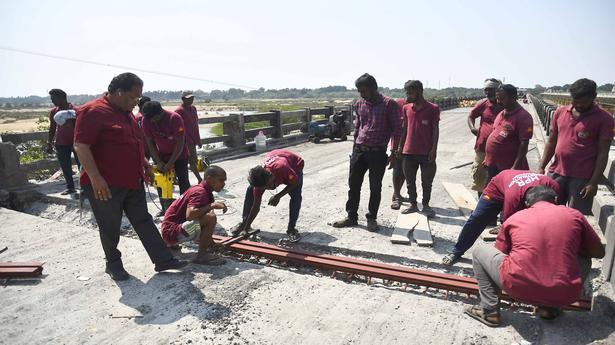
Work on old Palar bridge over; second bridge to be closed for repairs
The Hindu
traffic diversions to continue till March 20
With work to strengthen the old Palar bridge in Chengalpattu district on the NH 45 nearing completion, traffic from Chennai will be allowed on the facility from Thursday night. Collector Rahul Nadh, who inspected the restoration work by the National Highways Authority of India (NHAI) on Wednesday along with officials, said that traffic proceeding from Chennai towards the southern districts would be allowed on the old bridge after which the second bridge would be closed for repairs. “The existing diversion of traffic proceeding towards Chennai will continue till March 20 when the work on the second bridge is expected to be completed,” he said. During the initial days of the diversion, traffic had come to a standstill on the G.S.T Road since many motorists were not aware of it. “The biggest headache, even today, is of people trying to drive on the wrong side from the opposite side of the road. After a couple of days, many vehicles started taking the East Coast Road bringing some relief here,” said one of the workers, who helps with traffic. The 640-metre-long, two-lane wide bridge has 23 joints of which only 13 required repair. The second bridge, which is of the same length and width, has one additional joint and all of which require repair. Explaining the work being carried out on the bridges, an engineer associated with the project, said that a single long concrete piece cannot be laid and it is usually constructed in portions and joined together. At the end of each joint, the edges are sealed with a metal strip. The old bridge has copper plates, which have been replaced with modern steel strips. Due to the re-laying of the tar surface for years, the expansion joints were not visible to the naked eye. Workers cut open the joints till they reached the main rods, fixed the new metal strip according to the alignment, welded it with the parent rod, provided an anti-corrosive epoxy coat and then closed the openings and sealed it with micro-concrete. “Ordinary concrete takes 21 days to set. However, considering the need to finish the work soon, micro-concrete that sets in just seven days was used,” explained another source. Along with the restoration of joints, the hand rails were also repaired and painted. The work had been identified in 2017 but the permissions took time. Though the work order for the ₹1.41-crore project was issued to the contractor in November 2020, the work could not taken up due to the COVID-19 pandemic since the oxygen needed for welding could not be sourced, added another engineer. The foundation stone for the old bridge had been laid by the then Minister for Public Works of the erstwhile Government of Madras, M. Bhaktavatsalam, in May 1951. It was opened to traffic in June 1955. The second bridge was constructed in the 1980s.

 Run 3 Space | Play Space Running Game
Run 3 Space | Play Space Running Game
 Traffic Jam 3D | Online Racing Game
Traffic Jam 3D | Online Racing Game
 Duck Hunt | Play Old Classic Game
Duck Hunt | Play Old Classic Game

















